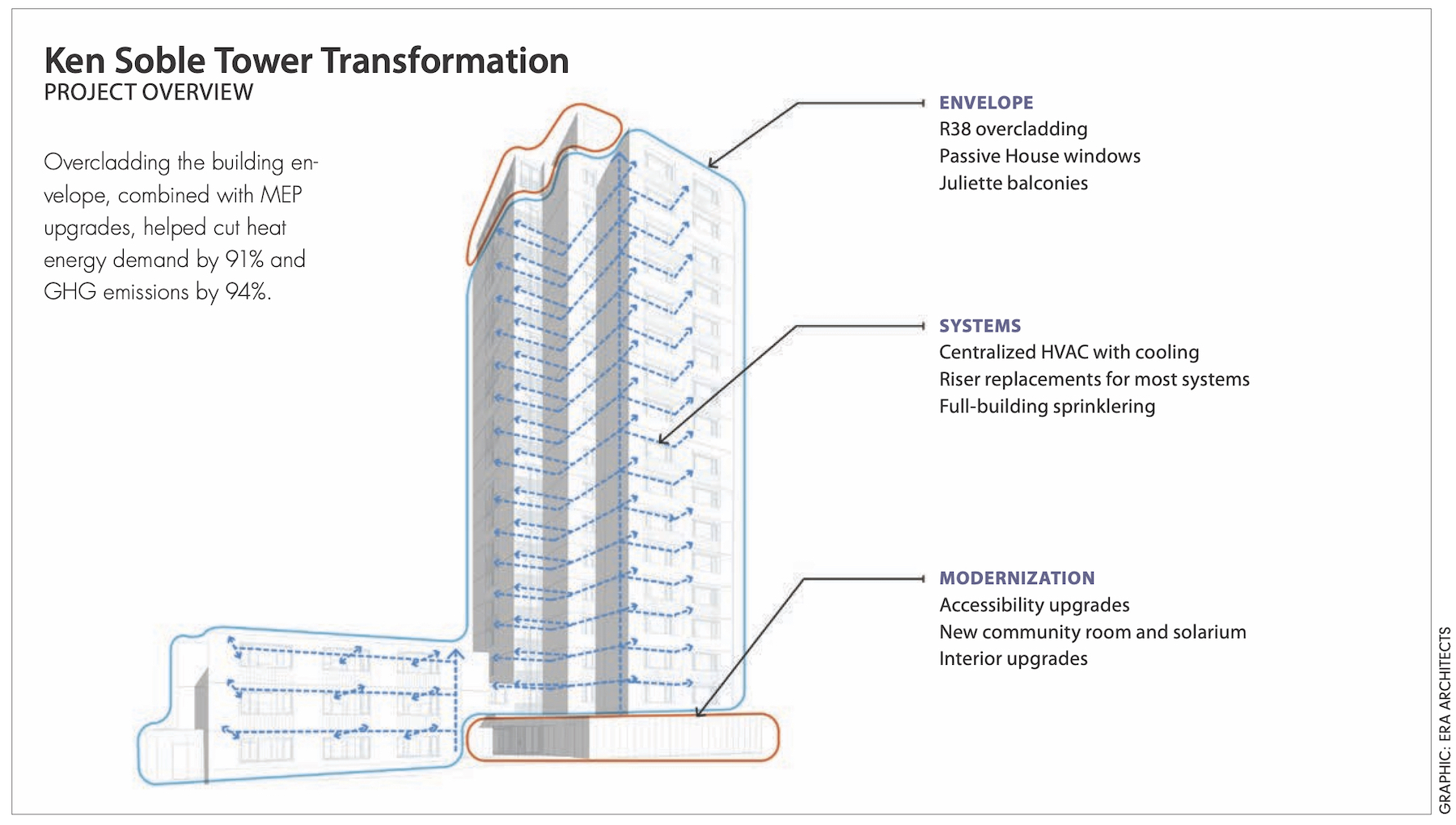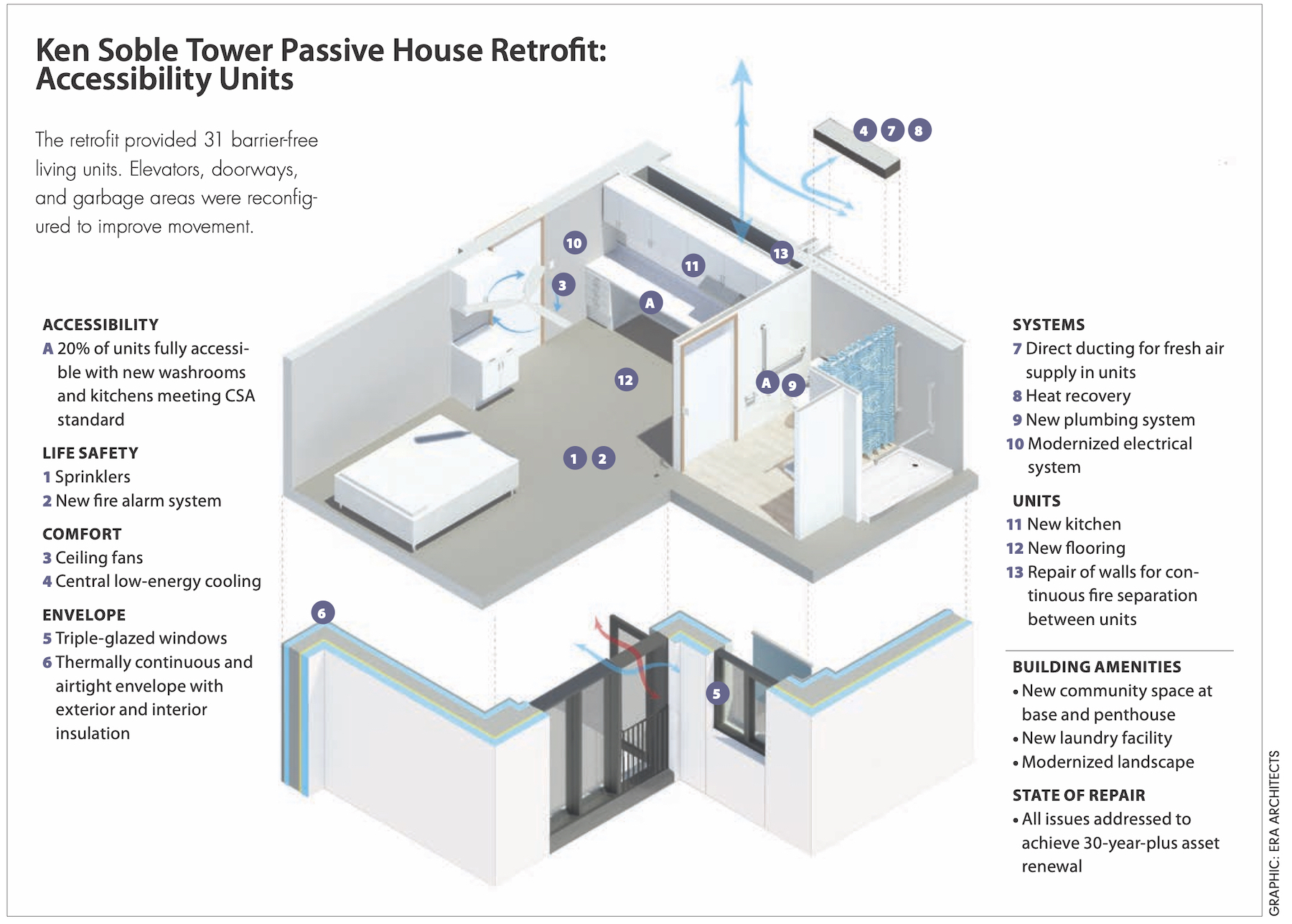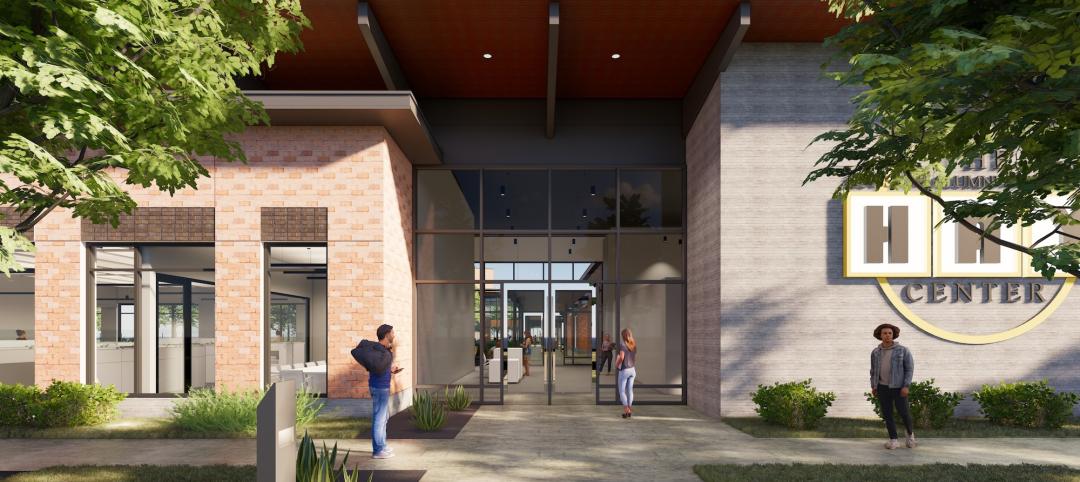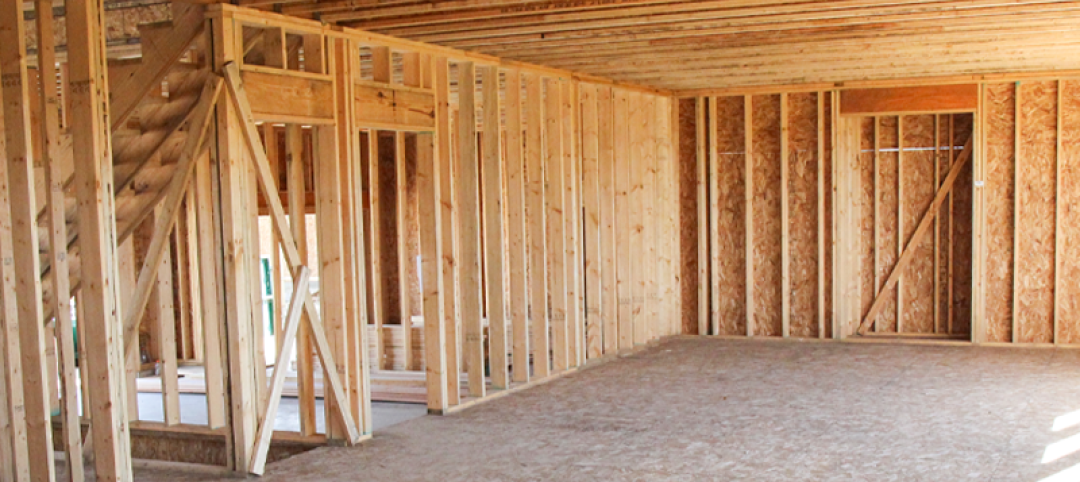Ken Soble Tower, an affordable housing high-rise for seniors in Hamilton, Ont., is now arguably the world’s largest residential building retrofitted to the Passive House standard.
Led by ERA Architects and PCL Construction, the project team slashed the 80,000-sf, 18-story building’s greenhouse gas emissions by 94% and its heating energy demand by 91% en route to achieving EnerPHit certification. The total energy needed to heat and cool one of its 146 units is now equivalent to that needed to power three 100-watt light bulbs.
Built in 1967 as part of the “North End Renewal” of West Harbour, an industrial neighborhood on Lake Ontario, the tower and an accompanying three-story walkup provided one-bedroom and bachelor apartments for families and single workingmen.
At the time, the complex, named after the founder of a local radio station and a local TV station, was considered a showcase property in the portfolio of CityHousing Hamilton, the municipal housing authority.
By 2012, however, the property was showing its age. The elevators constantly failed; so, too, the heating and cooling system. Mold, peeling paint, and water damage were apparent everywhere.
Worst of all: the pest problem. Forty-two percent of maintenance calls were for cockroaches, rodents, and bedbugs. The bedbug infestation was so bad the housing agency had to move whole floors of tenants to temporary housing on the 16th floor while crews tried to kill the critters. The bedbugs kept coming back.
The housing agency started relocating tenants. In less than four years, two-thirds of the apartments in Ken Soble Tower were vacant, despite a citywide waitlist of 6,000 families seeking affordable housing.

In 2015, CityHousing Hamilton, which manages 7,000 apartments in 1,265 properties, for 13,000 residents, surveyed the tower’s remaining residents about the future of the property; 83% responded. Their message to the agency: “Keep Ken Soble Tower.” A year later, the financial consulting firm Deloitte, acting on behalf of CityHousing Hamilton, studied the options—sell, demolish and rebuild, perform basic capital repairs, or refurbish—and came to the same conclusion: renovate.
The housing agency gave the go-ahead to completely retrofit Ken Soble Tower, a project that became part of Canada’s National Housing Strategy to modernize and decarbonize older affordable apartments. The project was folded into the Tower Renewal Partnership, an initiative by the nonprofit Centre for Urban Growth and Renewal (cugr.ca) to transform Southern Ontario’s stock of post-war apartment towers into more healthy, resilient, and complete communities.
A FIVE-PRONGED APPROACH TO RESTORATION
The renewal effort had five objectives:
- Modernize all 146 dwelling units.
- Attain EnerPHit certification, based on 2050 temperature projections, to cut GHG emissions by 94% and energy intensity by 70%.
- Allow for aging-in-place, by creating 31 barrier-free residences and reconfiguring elevators, doorways, and residential garbage areas to allow for barrier-free movement throughout the building.
- Address the housing authority’s 30-year capital repair program.
- Maintain “deep affordability,” through Hamilton’s Rent Geared to Income subsidy.
The building envelope consisted of composite masonry walls with minimal interior insulation and vapor control layers; it was sorely deteriorated. The design team’s first thought was to build an entire wall assembly outside the brick. Instead, the team overcladded the structure: first, with a liquid-applied air barrier; followed by a DuROCK PUCCS NC noncombustible rainscreen EIFS system, which incorporated 50,000 sf of a six-inch-thick layer of Rockwool stone wool insulation into the façade; finally, a stucco finish. Another four inches of mineral wool was added to the interior.
The EIFS system helped the project realize the R-38 effectiveness required to achieve EnerPHit certification. The retrofit resulted in a 94% reduction in GHG emissions and a 91% cut in heating energy demand. In practical terms, it meant that the building would stay warm in winter for up to two days and below dangerous heat levels in summer for up to four days.
Concrete slab balconies were replaced with juliettes to meet maintenance and accessibility requirements and eliminate thermal bridging. Easily operable triple-glazed windows and doors were installed to encourage natural ventilation. The roof membranes and below-grade waterproofing were replaced with fluid-applied products and upgraded with up to 16 inches of insulation.
Mechanical systems were completely overhauled with new central systems that provide tempered fresh air to each suite from rooftop energy recovery ventilators (ERVs), and individual control with in-suite variable-air volume (VAV) dampers with reheat. Common areas are served by smaller ERVs that are activated by occupancy sensors. A sophisticated building automation system will measure and verify that all building systems are functioning as designed.
The project came in at $34 million ($233,000/unit), 70% of which was for base building renewal, 30% for low-energy initiatives.
COMPREHENSIVE AIR TIGHTNESS TESTING
To achieve EnerPHit certification from Passive House Canada, the team developed a comprehensive air tightness testing and quality management program, led by PCL’s in-house building envelope engineering and construction team. Final operational whole building air tightness tests came in at 0.235 air changes/hr at 50 pa, beating the target by more than 50%.
One novel effort was that all building trades’ foremen and supervisors participated in a Passive House trades training session, with a focus on airtightness and reducing thermal bridging.

“Social sustainability” also played a part in the retrofit program. A dingy laundry room on the 18th floor was turned into a solarium, with views of the harbor. High-contrast wayfinding and bright color palettes were added to support community cohesion. Higher delivery of fresh air directly to units and the selection of low-VOC interior finishes greatly improved indoor air quality.
Adding to its distinctions, the Ken Soble Tower will become a teaching laboratory. CityHousing Hamilton, the University of Toronto, ERA Architects, and PCL Construction will, over the next two years, measure the impacts of the building on its residents and the surrounding environment, including building performance, occupant health and safety, and economic benefit.
PROJECT TEAM | KEN SOBLE TOWER
Owner: CityHousing Hamilton
Lead Architect/Interiors/Landscape Design: ERA Architects
Structural Engineer/Building Envelope Consultant: Entuitive
Mechanical Engineer: Reinbold Engineering Group
Electrical Engineer: Nemetz (S/A) & Associates
Passive House Consultants: JMV Consulting; Transsolar
Passive House Certifier: Herz & Lang GmbH
Building Envelope Testing: Engineering Link
Commissioning Consultant: CFMS Consulting Inc.
Elevators: Soberman Engineering
Building Code Consultant: LMDG Security/Telecoms Zerobit
Construction Consultant: SCR Consulting
Construction Manager: PCL Construction
Related Stories
MFPRO+ New Projects | Jul 27, 2023
OMA, Beyer Blinder Belle design a pair of sculptural residential towers in Brooklyn
Eagle + West, composed of two sculptural residential towers with complementary shapes, have added 745 rental units to a post-industrial waterfront in Brooklyn, N.Y. Rising from a mixed-use podium on an expansive site, the towers include luxury penthouses on the top floors, numerous market rate rental units, and 30% of units designated for affordable housing.
Affordable Housing | Jul 27, 2023
Houston to soon have 50 new residential units for youth leaving foster care
Houston will soon have 50 new residential units for youth leaving the foster care system and entering adulthood. The Houston Alumni and Youth (HAY) Center has broken ground on its 59,000-sf campus, with completion expected by July 2024. The HAY Center is a nonprofit program of Harris County Resources for Children and Adults and for foster youth ages 14-25 transitioning to adulthood in the Houston community.
Adaptive Reuse | Jul 27, 2023
Number of U.S. adaptive reuse projects jumps to 122,000 from 77,000
The number of adaptive reuse projects in the pipeline grew to a record 122,000 in 2023 from 77,000 registered last year, according to RentCafe’s annual Adaptive Reuse Report. Of the 122,000 apartments currently undergoing conversion, 45,000 are the result of office repurposing, representing 37% of the total, followed by hotels (23% of future projects).
Multifamily Housing | Jul 25, 2023
San Francisco seeks proposals for adaptive reuse of underutilized downtown office buildings
The City of San Francisco released a Request For Interest to identify office building conversions that city officials could help expedite with zoning changes, regulatory measures, and financial incentives.
Sponsored | Multifamily Housing | Jul 20, 2023
Fire-Rated Systems in Light-Frame Wood Construction
Find guidance on designing and building some of the most cost-effective, code-compliant fire-rated construction systems.
Multifamily Housing | Jul 13, 2023
Walkable neighborhoods encourage stronger sense of community
Adults who live in walkable neighborhoods are more likely to interact with their neighbors and have a stronger sense of community than people who live in car-dependent communities, according to a report by the Herbert Wertheim School of Public Health and Human Longevity Science at University of California San Diego.
Affordable Housing | Jul 12, 2023
Navigating homelessness with modular building solutions
San Francisco-based architect Chuck Bloszies, FAIA, SE, LEED AP, discusses his firm's designs for Navigation Centers, temporary housing for the homeless in northern California.
Sponsored | Fire and Life Safety | Jul 12, 2023
Fire safety considerations for cantilevered buildings [AIA course]
Bold cantilevered designs are prevalent today, as developers and architects strive to maximize space, views, and natural light in buildings. Cantilevered structures, however, present a host of challenges for building teams, according to José R. Rivera, PE, Associate Principal and Director of Plumbing and Fire Protection with Lilker.
Mass Timber | Jul 11, 2023
5 solutions to acoustic issues in mass timber buildings
For all its advantages, mass timber also has a less-heralded quality: its acoustic challenges. Exposed wood ceilings and floors have led to issues with excessive noise. Mass timber experts offer practical solutions to the top five acoustic issues in mass timber buildings.
















